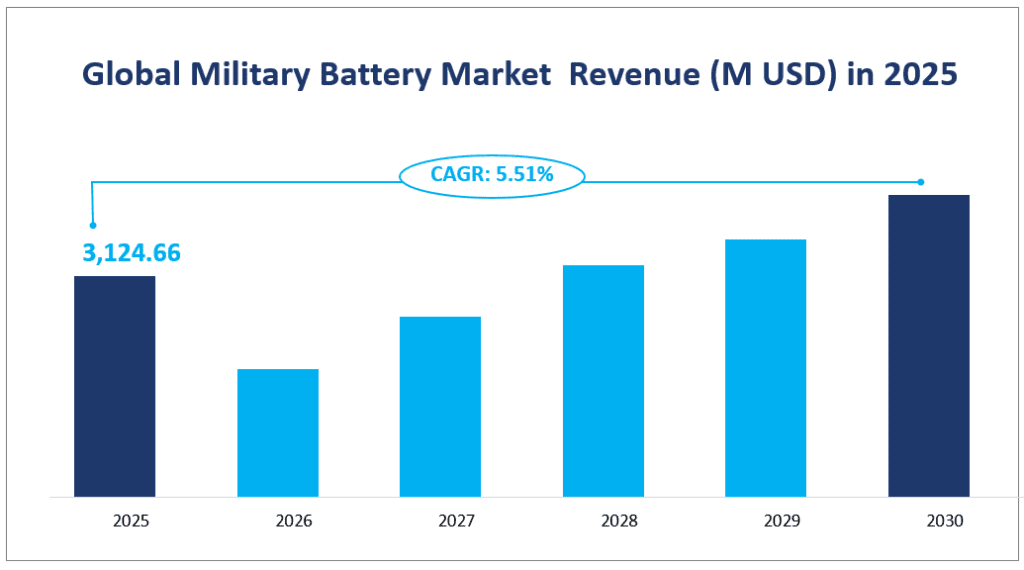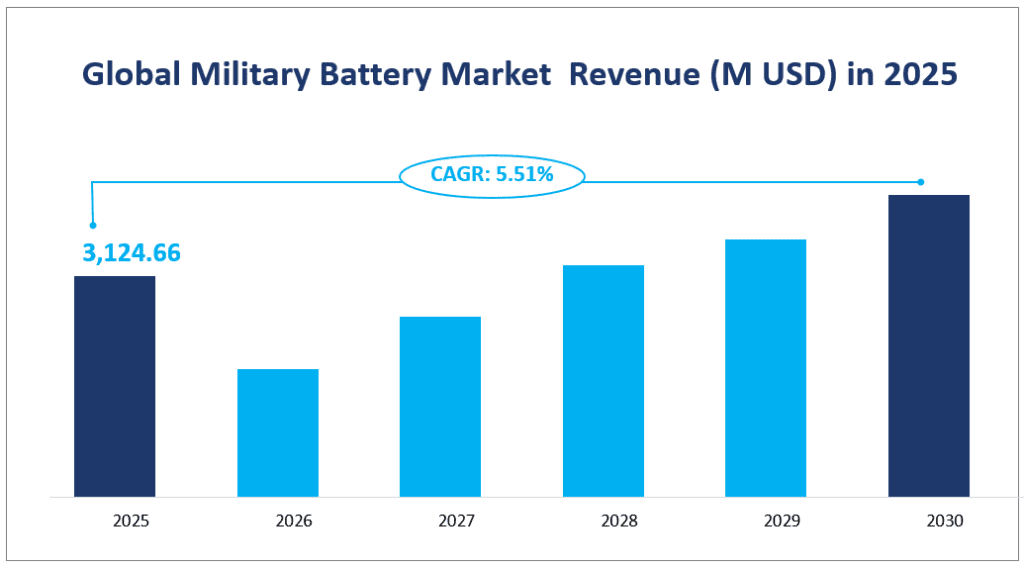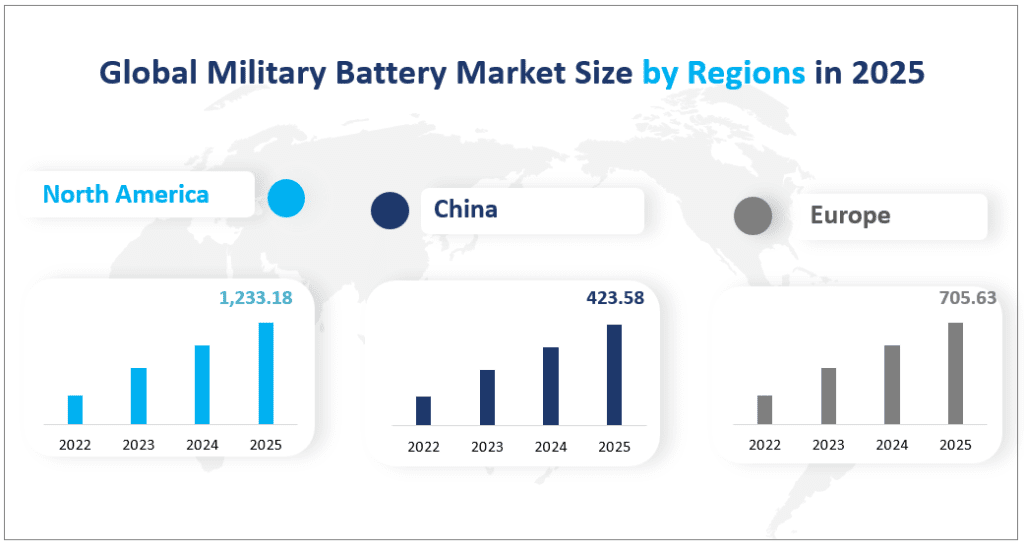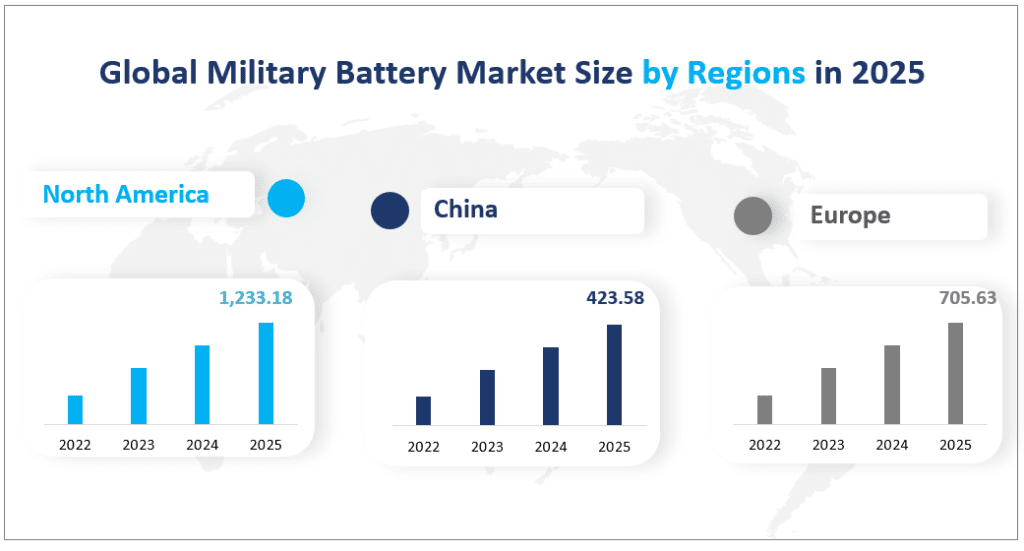1. Global Military Battery Market Overview
The global military battery market is projected to reach a revenue of $3,124.66 million by 2025, with a CAGR of 5.51% from 2025 to 2030.
A military battery is a specialized power storage device designed to meet the stringent requirements of military applications. These batteries are engineered to provide high energy density, high power output, and robustness under extreme conditions. They are used in various military equipment such as vehicles, aircraft, ships, operating bases, unmanned vehicles, and submarines. Military batteries also serve as backup power sources in scenarios where primary power sources may fail.
The unique demands of military operations require these batteries to be highly reliable, durable, and capable of withstanding harsh environmental conditions. This includes resistance to extreme temperatures, vibrations, and shocks. The development of military batteries involves advanced materials and technologies to ensure they meet the high standards required for military use.
Global Military Battery Market Revenue (M USD) in 2025


2. Driving Factors of the Military Battery Market
Firstly, the increasing defense budgets of various countries due to growing instances of transnational disputes have significantly fueled the demand for advanced military equipment, including high-performance batteries. Secondly, the emergence of modern warfare systems based on advanced technologies has created a higher demand for military batteries. Modern military land vehicles, for instance, are increasingly dependent on electrical energy for their functions. As these vehicles are fitted with more electronic equipment, their demand for electrical energy continues to rise. Inadequate electrical energy storage can inhibit operational performance, particularly during silent duty operations. Therefore, the development of high-capacity, high-power batteries is crucial to meet the evolving needs of modern military equipment.
3. Limiting Factors of the Military Battery Market
Despite the positive growth drivers, the military battery market faces several limitations. One of the primary challenges is the close contact with suppliers of raw materials. The global supply of raw materials for military batteries is relatively concentrated, with Asia and South America being the main supply regions. This concentration makes military-developed regions like North America and Europe more reliant on imports. The supply chain challenges are further exacerbated by long lead times for components and materials, which can complicate sudden increases in production when needed.
Another significant limitation is the risk of untimely product updates. As new weapons and military systems are designed around high energy density and lightweight battery technology, the reliance on these batteries is expected to grow exponentially. However, creating a battery that meets the stringent performance requirements without compromising on size, weight, or safety is a complex task. This challenge is particularly acute for Original Equipment Manufacturers (OEMs) as they integrate more features into communication devices and other military-related systems.
Finally, the uncertainty in defense spending and government budgets poses a significant threat to the military battery market. At the macroeconomic level, fluctuations in defense budgets make it difficult to forecast the overall market size accurately. This uncertainty inhibits investment in capabilities, leading to revenue volatility, underinvestment in capital, and suboptimal investment in research and development. Over time, these factors can create market distortions, leaving suppliers with excess capacity when programs end, thereby affecting the long-term stability of the military battery market.
4. Analysis of the Global Military Battery Market Segment
Product Types
Lithium batteries are anticipated to generate a revenue of $1,867.26 million by 2025. These batteries are highly valued for their superior energy density and power output, making them ideal for a wide range of military applications. Their ability to provide high energy in a compact form factor is particularly advantageous for portable devices and systems that require long-lasting power. The growth rate of lithium batteries is expected to be robust, driven by continuous advancements in technology and increasing demand for lightweight, high-performance power solutions.
Lead acid batteries are projected to achieve a revenue of $744.80 million by 2025. Despite being one of the oldest battery technologies, lead-acid batteries remain relevant in the military sector due to their reliability and cost-effectiveness. The growth rate of lead-acid batteries is expected to be moderate, as they continue to serve traditional applications while facing competition from newer, more advanced battery technologies.
Nickel batteries are expected to generate a revenue of $300.41 million by 2025. These batteries offer a balance between energy density and cost, making them suitable for applications that require moderate power and energy storage. Nickel batteries are often used in communication systems, portable electronics, and some specialized military equipment. Their growth rate is anticipated to be steady, driven by ongoing demand in niche markets and specific military applications.
Thermal batteries are projected to achieve a revenue of $44.03 million by 2025. These specialized batteries are designed for high-power, short-duration applications, such as missile systems and other defense-related equipment. Their unique ability to provide a burst of energy makes them indispensable in certain military operations. While the market size for thermal batteries is relatively smaller compared to other types, their growth rate is expected to be significant due to the increasing demand for high-performance, specialized power solutions in modern warfare.
Market by Applications
Propulsion Systems: These systems are essential for powering military vehicles, aircraft, and naval vessels. In 2025, the market volume for propulsion systems is expected to reach 407.2 K Units. This application is critical for ensuring the mobility and operational readiness of military assets. The demand for high-performance batteries that can provide sustained power over long durations drives the consumption in this segment.
Auxiliary Power Units (APU): APUs are used to provide power for functions other than propulsion, such as electrical systems, heating, and cooling. The market volume for APUs in 2025 is forecasted to be 306.1 K Units. These units are vital for maintaining the functionality of military equipment during periods when the main propulsion system is not in use, ensuring that critical systems remain operational.
Backup Power: Backup power systems are indispensable for ensuring an uninterrupted power supply in critical military operations. The market volume for backup power in 2025 is projected to be 525.7 K Units. This segment is expected to grow significantly due to the increasing reliance on electronic systems that require constant power to function effectively.
Ignition Systems: Ignition systems are crucial for starting engines and other combustion-based systems. The market volume for ignition systems in 2025 is estimated at 203.6 K Units. These systems require reliable batteries to ensure quick and efficient ignition, especially in harsh military environments.
Communication & Navigation Systems: Effective communication and navigation are vital for military operations. The market volume for communication & navigation systems in 2025 is expected to be 373.0 K Units. These systems require high-performance batteries to ensure reliable operation over extended periods.
Fire Control Systems: Fire control systems are essential for the accurate targeting and firing of weapons. The market volume for fire control systems in 2025 is projected to be 248.2 K Units. These systems demand precise and reliable power sources to ensure accurate and timely operation.
Electro-Optics & Thermal Imaging Systems: These systems are used for surveillance and reconnaissance. The market volume for electro-optics & thermal imaging systems in 2025 is expected to be 215.7 K Units. The demand for high-resolution imaging systems drives the need for advanced batteries that can support these technologies.
Among the various applications, backup power is expected to hold the largest military battery market share in 2025. This segment’s dominance can be attributed to the critical need for uninterrupted power in military operations, where the failure of power systems can have severe consequences.
In terms of growth rate, the backup power segment is also anticipated to experience the fastest growth. The projected growth rate for backup power systems is driven by the increasing complexity and reliance on electronic systems in modern military operations. As military forces continue to adopt advanced technologies that require constant power, the demand for reliable backup power solutions is expected to rise significantly.
Marke Revenue and Consumption by Segment
| Market Revenue (M USD) in 2025 | ||
| By Type | Lithium Battery | 1867.26 |
| Lead Acid Battery | 744.80 | |
| Nickel Battery | 300.41 | |
| Thermal Battery | 44.03 | |
| By Application | Consumption Volume (K Units) in 2025 | |
| Propulsion Systems | 407.2 | |
| Auxiliary Power Units (APU) | 306.1 | |
| Backup Power | 525.7 | |
| Ignition Systems | 203.6 | |
| Communication & Navigation Systems | 373.0 | |
| Fire Control Systems | 248.2 | |
| Electro Optics & Thermal Imaging Systems | 215.7 |
5. Regional Analysis of the Global Military Battery Market
The United States is anticipated to be the largest regional military battery market for military batteries by 2025, with a projected revenue of $1,233.18 million. The U.S. military’s extensive use of advanced technologies and its significant defense budget allocation drive the demand for high-performance military batteries. The country’s robust industrial base and focus on innovation further support the growth of this market segment. The U.S. military’s reliance on cutting-edge communication systems, unmanned vehicles, and other high-tech equipment ensures a steady demand for advanced battery solutions.
Europe is expected to generate a revenue of $705.63 million by 2025. The region’s strong defense industry and commitment to maintaining advanced military capabilities contribute to its significant market share. European countries, particularly those in NATO, invest heavily in modernizing their military equipment, driving the demand for reliable and high-performance batteries. The growth rate in Europe is expected to be moderate but steady, supported by ongoing defense modernization programs and regional security concerns.
China is projected to achieve a revenue of $423.58 million by 2025. The rapid modernization of China’s military and its focus on developing advanced defense technologies drive the demand for military batteries. China’s growing defense budget and investment in research and development contribute to the development of high-capacity and high-performance batteries. The country’s focus on self-reliance in defense technology also supports the growth of its domestic military battery market.
Japan is expected to generate a revenue of $55.38 million by 2025. The country’s advanced defense industry and focus on high-tech military equipment drive the demand for specialized batteries. Japan’s investment in defense research and development, particularly in areas such as missile defense and advanced electronics, supports the growth of this market segment. The growth rate in Japan is expected to be moderate, driven by ongoing defense modernization efforts and regional security concerns.
Southeast Asia is expected to generate a revenue of $108.42 million by 2025. The region’s growing defense spending and focus on modernizing its military capabilities drive the demand for advanced batteries. Countries in Southeast Asia, particularly Indonesia, Thailand, and Malaysia, are investing in defense modernization programs, driving the demand for high-performance batteries. The growth rate in Southeast Asia is expected to be strong, driven by ongoing defense modernization efforts and regional security concerns.
The GCC countries are expected to generate a revenue of $108.28 million by 2025. The region’s significant defense spending and focus on maintaining advanced military capabilities drive the demand for high-performance batteries. Countries in the GCC, particularly Saudi Arabia and the United Arab Emirates, invest heavily in defense modernization programs, driving the demand for advanced battery solutions. The growth rate in the GCC region is expected to be strong, driven by ongoing defense modernization efforts and regional security concerns.
Global Military Battery Market Size by Regions in 2025


6. Top 3 Companies in the Military Battery Market
Company Introduction and Business Overview: Saft is a leading provider of advanced technology batteries and systems, with a history dating back to 1918. The company specializes in designing, developing, and manufacturing rechargeable and non-rechargeable batteries for a wide range of applications, including aerospace, defense, medical, telecommunications, and transportation. Saft’s manufacturing bases are primarily located in North America, Europe, and Asia, serving a global market.
Products Offered: Saft offers a variety of high-performance batteries, including lithium-ion batteries, nickel-cadmium batteries, and lithium-metal batteries. Their products are designed to meet the stringent requirements of military applications, providing high energy density, reliability, and durability.
Company Introduction and Business Overview: EnerSys is a global leader in stored energy solutions for industrial applications. Established in 2000, the company offers a comprehensive range of motive power, reserve power, aerospace/defense, and specialty batteries. EnerSys’ manufacturing facilities are primarily located in North America and Europe, serving customers worldwide.
Products Offered: EnerSys provides a wide range of batteries, including lead-acid batteries, lithium-ion batteries, and nickel-based batteries. Their products are designed to meet the specific needs of various industries, including the military, where reliability and performance are critical.
Company Introduction and Business Overview: EaglePicher Technologies is a leading producer of batteries and energetic devices, with a history dating back to 1842. The company specializes in serving the mission-critical aerospace, defense, aviation, and medical battery markets. EaglePicher’s manufacturing facilities are primarily located in the United States, serving both domestic and international customers.
Products Offered: EaglePicher offers a variety of high-performance batteries, including lithium-ion batteries, nickel-cadmium batteries, and thermal batteries. Their products are designed to meet the stringent requirements of military applications, providing high energy density, reliability, and durability.
Major Players
| Company Name | Plant Locations | Market Distribution |
| Saft | Mainly in North America, Europe, and Asia | Worldwide |
| EnerSys | Mainly in North America and Europe | Worldwide |
| EaglePicher Technologies | In the United States | Mainly in the United States |
| Concorde Battery | In the United States | Mainly in North America |
| Bren-Tronics, Inc. | In the United States | Mainly in North America and Europe |
| Teledyne Battery | In the United States | Mainly in the United States |
| Mathews Associates | In the United States | Mainly in the United States |
| Kokam | South Korea | Mainly in Asia |
| Ultralife | Mainly in the United States | Mainly in North America, Europe, and Asia |
| Navitas Systems | In the United States | Mainly in North America |
| BST Systems | In the United States | Mainly in the United States |
| Arotech Corporation | In the United States | Mainly in the United States |
| Denchi Power | In the United States | Mainly in North America |
| HBL Power Systems Ltd | Mainly in Asia | Mainly in North America, Europe, and Asia |
| Lincad | UK | Mainly in North America and Europe |
1 Market Overview
1.1 Military Battery Introduction
1.2 Market Analysis by Types
1.3 Market Analysis by Application
1.4 Market Analysis by Regions
1.4.1 United States Market States and Outlook (2015-2027)
1.4.2 Europe Market States and Outlook (2015-2027)
1.4.3 China Market States and Outlook (2015-2027)
1.4.4 Japan Market States and Outlook (2015-2027)
1.4.5 Southeast Asia Market States and Outlook (2015-2027)
1.4.6 India Market States and Outlook (2015-2027)
1.4.7 Brazil Market States and Outlook (2015-2027)
1.4.8 GCC Countries Market States and Outlook (2015-2027)
1.5 Market Dynamics and Development
1.5.1 Merger, Acquisition and New Investment
1.5.2 Market SWOT Analysis
1.5.3 Drivers
1.5.4 Limitations
1.5.5 Opportunities and Development Trends
1.6 Global Military Battery Market Size Analysis from 2015 to 2027
1.6.1 Global Military Battery Market Size Analysis from 2015 to 2027 by Consumption Volume
1.6.2 Global Military Battery Market Size Analysis from 2015 to 2027 by Value
1.6.3 Global Military Battery Price Trends Analysis from 2015 to 2027
1.7 Military Battery Industry Development Trends under COVID-19 Outbreak
1.7.1 Global COVID-19 Status Overview
1.7.2 Influence of COVID-19 Outbreak on Military Battery Industry Development
2 Global Military Battery Competition by Types, Applications, and Top Regions and Countries
2.1 Global Military Battery (Volume and Value) by Type
2.1.1 Global Military Battery Consumption and Market Share by Type (2015-2020)
2.1.2 Global Military Battery Revenue and Market Share by Type (2015-2020)
2.2 Global Military Battery (Volume and Value) by Application
2.2.1 Global Military Battery Consumption and Market Share by Application (2015-2020)
2.2.2 Global Military Battery Revenue and Market Share by Application (2015-2020)
2.3 Global Military Battery (Volume and Value) by Regions
2.3.1 Global Military Battery Consumption and Market Share by Regions (2015-2020)
2.3.2 Global Military Battery Revenue and Market Share by Regions (2015-2020)
3 United States Military Battery Market Analysis
3.1 United States Military Battery Consumption and Value Analysis
3.1.1 United States Military Battery Market Under COVID-19
3.2 United States Military Battery Consumption Volume by Types
3.3 United States Military Battery Consumption Structure by Application
4 Europe Military Battery Market Analysis
4.1 Europe Military Battery Consumption and Value Analysis
4.1.1 Europe Military Battery Market Under COVID-19
4.2 Europe Military Battery Consumption Volume by Types
4.3 Europe Military Battery Consumption Structure by Application
4.4 Europe Military Battery Consumption by Top Countries
4.4.1 Germany Military Battery Consumption Volume from 2015 to 2020
4.4.2 UK Military Battery Consumption Volume from 2015 to 2020
4.4.3 France Military Battery Consumption Volume from 2015 to 2020
4.4.4 Italy Military Battery Consumption Volume from 2015 to 2020
4.4.5 Spain Military Battery Consumption Volume from 2015 to 2020
4.4.6 Poland Military Battery Consumption Volume from 2015 to 2020
4.4.7 Russia Military Battery Consumption Volume from 2015 to 2020
5 China Military Battery Market Analysis
5.1 China Military Battery Consumption and Value Analysis
5.1.1 China Military Battery Market Under COVID-19
5.2 China Military Battery Consumption Volume by Types
5.3 China Military Battery Consumption Structure by Application
6 Japan Military Battery Market Analysis
6.1 Japan Military Battery Consumption and Value Analysis
6.1.1 Japan Military Battery Market Under COVID-19
6.2 Japan Military Battery Consumption Volume by Types
6.3 Japan Military Battery Consumption Structure by Application
7 Southeast Asia Military Battery Market Analysis
7.1 Southeast Asia Military Battery Consumption and Value Analysis
7.1.1 Southeast Asia Military Battery Market Under COVID-19
7.2 Southeast Asia Military Battery Consumption Volume by Types
7.3 Southeast Asia Military Battery Consumption Structure by Application
7.4 Southeast Asia Military Battery Consumption by Top Countries
7.4.1 Indonesia Military Battery Consumption Volume from 2015 to 2020
7.4.2 Thailand Military Battery Consumption Volume from 2015 to 2020
7.4.3 Philippines Military Battery Consumption Volume from 2015 to 2020
7.4.4 Malaysia Military Battery Consumption Volume from 2015 to 2020
7.4.5 Singapore Military Battery Consumption Volume from 2015 to 2020
7.4.6 Vietnam Military Battery Consumption Volume from 2015 to 2020
8 India Military Battery Market Analysis
8.1 India Military Battery Consumption and Value Analysis
8.1.1 India Military Battery Market Under COVID-19
8.2 India Military Battery Consumption Volume by Types
8.3 India Military Battery Consumption Structure by Application
9 Brazil Military Battery Market Analysis
9.1 Brazil Military Battery Consumption and Value Analysis
9.1.1 Brazil Military Battery Market Under COVID-19
9.2 Brazil Military Battery Consumption Volume by Types
9.3 Brazil Military Battery Consumption Structure by Application
10 GCC Countries Military Battery Market Analysis
10.1 GCC Countries Military Battery Consumption and Value Analysis
10.1.1 GCC Countries Military Battery Market Under COVID-19
10.2 GCC Countries Military Battery Consumption Volume by Types
10.3 GCC Countries Military Battery Consumption Structure by Application
10.4 GCC Countries Military Battery Consumption Volume by Major Countries
10.4.1 Saudi Arabia Military Battery Consumption Volume from 2015 to 2020
10.4.2 United Arab Emirates Military Battery Consumption Volume from 2015 to 2020
10.4.3 Qatar Military Battery Consumption Volume from 2015 to 2020
10.4.4 Bahrain Military Battery Consumption Volume from 2015 to 2020
11 Manufacturers Profiles
11.1 Saft
11.1.1 Business Overview
11.1.2 Products Analysis
11.1.3 Saft Military Battery Sales, Price, Revenue, Gross Margin
11.2 EnerSys
11.2.1 Business Overview
11.2.2 Products Analysis
11.2.3 EnerSys Military Battery Sales, Price, Revenue, Gross Margin
11.3 EaglePicher Technologies
11.3.1 Business Overview
11.3.2 Products Analysis
11.3.3 EaglePicher Technologies Military Battery Sales, Price, Revenue, Gross Margin
11.4 Concorde Battery
11.4.1 Business Overview
11.4.2 Products Analysis
11.4.3 Concorde Battery Military Battery Sales, Price, Revenue, Gross Margin
11.5 Bren-Tronics, Inc.
11.5.1 Business Overview
11.5.2 Products Analysis
11.5.3 Bren-Tronics, Inc. Military Battery Sales, Price, Revenue, Gross Margin
11.6 Teledyne Battery
11.6.1 Business Overview
11.6.2 Products Analysis
11.6.3 Teledyne Battery Military Battery Sales, Price, Revenue, Gross Margin
11.7 Mathews Associates
11.7.1 Business Overview
11.7.2 Products Analysis
11.7.3 Mathews Associates Military Battery Sales, Price, Revenue, Gross Margin
11.8 Kokam
11.8.1 Business Overview
11.8.2 Products Analysis
11.8.3 Kokam Military Battery Sales, Price, Revenue, Gross Margin
11.9 Ultralife
11.9.1 Business Overview
11.9.2 Products Analysis
11.9.3 Ultralife Military Battery Sales, Price, Revenue, Gross Margin
11.10 Navitas Systems
11.10.1 Business Overview
11.10.2 Products Analysis
11.10.3 Navitas Systems Military Battery Sales, Price, Revenue, Gross Margin
11.11 BST Systems
11.11.1 Business Overview
11.11.2 Products Analysis
11.11.3 BST Systems Military Battery Sales, Price, Revenue, Gross Margin
11.12 Arotech Corporation
11.12.1 Business Overview
11.12.2 Products Analysis
11.12.3 Arotech Corporation Military Battery Sales, Price, Revenue, Gross Margin
11.13 Denchi Power
11.13.1 Business Overview
11.13.2 Products Analysis
11.13.3 Denchi Power Military Battery Sales, Price, Revenue, Gross Margin
11.14 HBL Power Systems Ltd
11.14.1 Business Overview
11.14.2 Products Analysis
11.14.3 HBL Power Systems Ltd Military Battery Sales, Price, Revenue, Gross Margin
11.15 Lincad
11.15.1 Business Overview
11.15.2 Products Analysis
11.15.3 Lincad Military Battery Sales, Price, Revenue, Gross Margin
12 Marketing Strategy Analysis
12.1 Marketing Channel
12.1.1 Marketing Channel Development Trend
12.2 Market Positioning
12.2.1 Pricing Strategy
12.2.2 Brand Strategy
12.2.3 Target Client
12.3 Distributors/Traders List
13 Global Military Battery Market Forecast (2020-2027)
13.1 Global Military Battery Consumption Volume, Revenue and Price Forecast (2020-2027)
13.1.1 Global Military Battery Consumption Volume and Growth Rate Forecast (2020-2027)
13.1.2 Global Military Battery Value and Growth Rate Forecast (2020-2027)
13.1.3 Global Military Battery Price and Trend Forecast (2020-2027)
13.2 Global Military Battery Consumption Volume, Value and Growth Rate Forecast by Region (2020-2027)
13.2.1 Global Military Battery Consumption Volume and Growth Rate Forecast by Regions (2020-2027)
13.2.2 Global Military Battery Value and Growth Rate Forecast by Regions (2020-2027)
13.3 Global Military Battery Consumption Volume, Revenue and Price Forecast by Type (2020-2027)
13.3.1 Global Military Battery Consumption Forecast by Type (2020-2027)
13.3.2 Global Military Battery Revenue Forecast by Type (2020-2027)
13.3.3 Global Military Battery Price Forecast by Type (2020-2027)
13.4 Global Military Battery Consumption Volume Forecast by Application (2020-2027)
13.5 Military Battery Market Forecast Under COVID-19
14 Research Conclusions
15 Appendix
15.1 Methodology
15.2 Research Data Source
